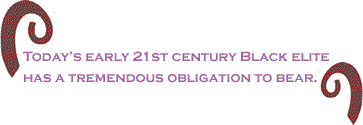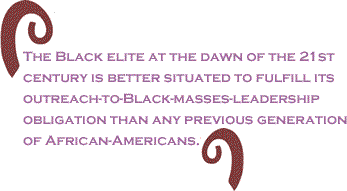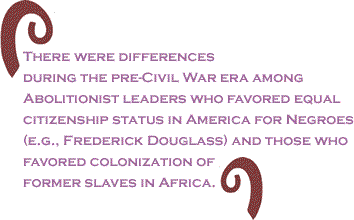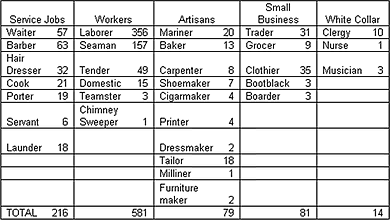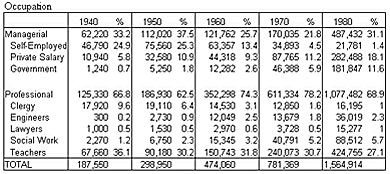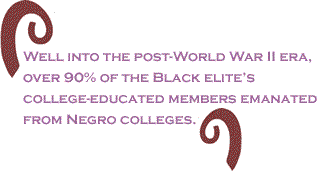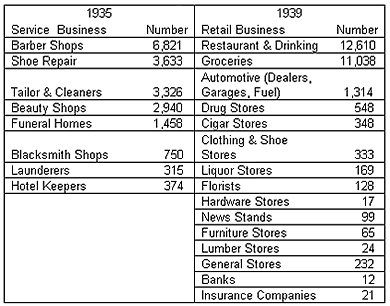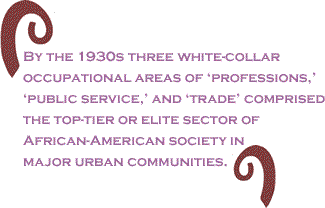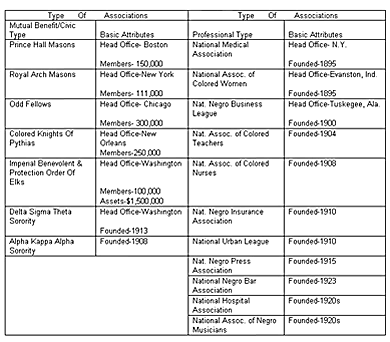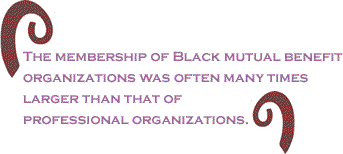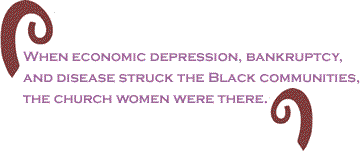
|
|||||||||||||||||||||
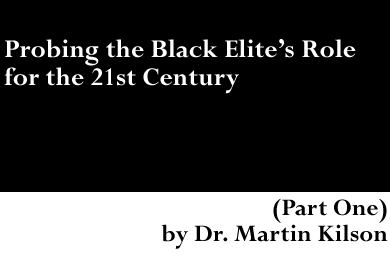 |
This is the first of a three-part series from Dr. Kilson, the first Black tenured professor at Harvard University. Writing a century ago in the quintessential African-American text, The Souls of Black Folk (1903), the great W.E.B. DuBois committed himself to and charged the then fledgling Negro elite – the “Talented Tenth” as DuBois called it – with the obligation of advancing the racist-ravaged plight of the masses of Negro Americans. In general, the role of the Black elite in 21st century African-American society should be the same role it has played since the dawn of its existence among the small Free Negro communities in pre-Emancipation Era American society. Namely, the outreach-to-Black-popular-society-leadership role, the outreach-to-Black-masses-leadership role, if you will. In this essay I want to reflect on the issue of what the outreach-to-Black-masses-leadership profile of today’s Black elite should be by looking back historically to how this leadership profile evolved out of fragile Free Negro communities in the pre-Emancipation Era. It is unmistakably clear from today’s vantage point that the Black elite at the dawn of the 21st century is better situated – has more social, economic, and political capabilities – to fulfill its outreach-to-Black-masses-leadership obligation than any previous generation of African-Americans with middle-class and professional-class attributes.
Overview And Background Of The Black Elite Historically, in overall Black American leadership terms, what I call the outreach-to-Black-popular-society-leadership focus has been the defining leadership orientation of the main body of the African-American elite since its embryonic origins in pre-Emancipation Era Free Negro communities outside the South in Maryland, Delaware, Pennsylvania, New York, New Jersey, Massachusetts, and elsewhere. The origins of the outreach-to-Black-masses-leadership character of the small well-educated and economic well-off sector of African-Americans – the Black elite – are brilliantly probed in Gary Nash’s Forging Freedom: The Formation of Philadelphia’s Black Community, 1720-1840 (1988) and in the equally brilliant work by Julie Winch – Philadelphia’s Black Elite: Activism, Accommodation, and the Struggle for Autonomy, 1787-1848 (1988). There were, of course, ideological differences that surrounded the issue of how to execute the outreach-to-Black-masses-leadership orientation. Differences during the pre-Civil War era among Abolitionist leaders who favored equal citizenship status in America for Negroes (e.g., Frederick Douglass) and those who favored colonization of former slaves in Africa, Liberia in particular (e.g., Henry Highland Garnet). Or differences during the 20th century between Booker T. Washington and his Tuskegee Machine who fashioned the “accommodationism” leadership paradigm that acquiesced in American racism’s denial of Negroes’ claim for equality in citizenship and human rights, on the one hand, and on the other hand the leadership paradigm associated with W.E.B. DuBois and the Niagara Movement and NAACP that favored civil rights activism on behalf of Negroes’ citizenship and human rights equality. Also differences during the 20th century between the Black Nationalist leadership paradigm best represented by Marcus Garvey’s Universal Negro Improvement Association, on the one hand, and on the other hand the integrationist leadership approach of the mainline African-American civil rights intelligentsia represented by the NAACP, the National Council of Negro Women, the National Urban League, among other organizations. I probe the influence of these differences on 20th century Black intellectuals in my forthcoming book, The Making of Black Intellectuals: Studies on the African-American Intelligentsia.
No doubt the historical effectiveness of the African-American elite’s outreach-to-Black-masses-leadership orientation in any given period (pre-Civil War period, post-Emancipation Era, early 20th century period, middle-20th century period, etc.) was not perfect, by any means. However, the imperfections in any given historical period were related mainly to the anti-Negro character of the presumed democratic American system. First, to the oppressive, cruel, and authoritarian – nay, totalitarian – American slavocracy that reigned from the founding of the American Republic to its defeat in the Civil War. (For a summary but historically graphic account of American slavocracy, see James Oliver Horton and Lois Horton, Slavery and the Making of America [2005]). Second, to the White supremacist system (both its so-called legal forms and its anti-Negro terrorist forms as exemplified in the Ku Klux Klan and in racist judicial and police practices) that smashed the democratic promise of Reconstruction, a promise brilliantly probed by W.E.B. DuBois in Black Reconstruction in America (1935). And third, to the tenacious unwillingness of post-Civil Rights Movement era American political and economic processes to fashion public and private-sector policies that would close the persistent Black/White social mobility gap (average income/wealth gap, education opportunity gap, poverty gap, etc.). The social-mobility gap feature of the American system’s interface with African-American citizens is treated in Thomas Shapiro’s The Hidden Cost of Being African American (2004). The fledgling character of the embryonic Black elite stratum during the pre-Civil War era can be gauged from data shown in TABLE I, which presents selected occupation data on Boston’s Free Negro community in 1850 (population 2000). As the study, Black Bostonians: Family Life and Community Struggle in the Antebellum North (1999) by James Horton and Lois Horton informs us, it was barely a handful of early 19th century Boston Negroes who functioned as a “leadership sector” or an “elite sector,” that handful found among “artisans,” “small businesspersons,” and “white-collar persons.” Table I SELECTED OCCUPATIONS IN BOSTON’S FREE NEGRO COMMUNITY, 1850 Click to view larger and printer friendly table Source: African Americans in Antebellum Boston (primaryresearch.org).
Clergymen dominated white-collar occupations among Free Negroes in Boston, as they also did in other antebellum Free Negro communities. This meant, in turn, that from the pre-Civil War era down through the early 20th century, clergypersons performed an important part of what I call the outreach-to-Black-masses-leadership role, with clergy in the African Methodist Episcopal Church performing a cutting-edge function in this sphere, a subject brilliantly brought to life in Annetta Gomez-Jefferson’s book, The Sage of Tawawa: Reverdy Cassius Ransom, 1861-1959 (2002). A bishop in the African Methodist Episcopal Church, Reverdy Ransom was equal-part a progressive theologian and political activist, joining W.E.B. DuBois and Monroe Trotter in launching the Niagara Movement in 1905, the main predecessor civil rights activist African-American leadership thrust to the NAACP. In his outreach-to-Black-masses-leadership role, Bishop Reverdy Ransom was part of a cadre of great outreach-to-Black-masses oriented African Methodist Episcopal clergy such as Bishop Daniel Alexander Payne, Bishop Henry McNeal Turner, Bishop William Dickerson, Bishop Benjamin O. Tanner, Bishop R.R. Wright Jr., to mention just a few. The prominent position of the Black clergy among white-collar occupations persisted throughout the post-Emancipation Era and into the early 20th century. By 1890 teachers were the largest white-collar group among African-Americans numbering 14,100, followed by the clergy at 12,159, and by 1910 teachers numbered 29,485 and clergy numbered 17,495. (See Census Bureau data in Manning Marable, How Capitalism Underdeveloped Black America (1983) pp. 204-205). As shown in TABLE II, teachers continued as a prominent white-collar group among African-Americans throughout the 20th century, but the Black clergy was outdistanced by white-collar African-Americans in business by the 1940s, by Black social workers in 1960, by Black government white-collar employees in 1970, and by Black engineers in 1970. Table II SELECTED WHITE-COLLAR OCCUPATIONS HELD BY BLACKS 1940-1980 Click to view larger and printer friendly table Source: Gerald Jaynes and Robin Williams, A Common Destiny: Blacks And American Society (Washington, D.C.: National Academy of Sciences, 1989) p. 170.
As Horace Mann Bond—the first African-American president of Lincoln University (Pennsylvania)—revealed in his classic study Education of the Negro in the American Social Order (1934), by the 1930s – some three generations after the Civil War – the combined endeavor of the Negro church, African-American professional associations, and a few liberal White churches (Presbyterian, Methodist Episcopal, Congregationalist, and Quaker) had organized a network of higher education institutions for producing the core occupations of the Black elite (scholars, clergy, lawyers, doctors, dentists, scientists, technicians, administrators, etc.). Data assembled by the Tuskegee Institute scholar Monroe Work in The Negro Year Book: An Annual Encyclopedia of the Negro 1931-1932 (Tuskegee Institute, 1931) show that some 105 Negro colleges had been established by 1930. The crucial importance of Negro colleges to the structure of the Black elite is underlined by the fact that until well into the post-World War II era, over 90% of the Black elite’s college-educated members emanated from Negro colleges, starting with the founding by White abolitionist churches of the first two Negro colleges just before the Civil War in the 1850s (Lincoln University – 1854, Wilberforce University – 1856) and others founded in the Reconstruction Era onward. In regard to African-American access to White colleges, by the 1940s, for example, fewer than 50 African-Americans were allowed to attend the state-funded University of Illinois system, which is to say that without Negro colleges there would not be a viable African-American elite sector today. During 1930, some 2,071 African-Americans gained Bachelor degrees in the Arts and Sciences and the total number of students enrolled at Negro colleges was 25,883 (16,443 at private Negro colleges and 9,440 at state-aided Negro colleges). There were also 861 African-American students enrolled at Negro professional schools – 133 law, 449 medicine, 155 dentistry, and 119 pharmacy. Those professional schools were as follows: Howard University Law School, Virginia Union University Law School, Central Law School at Simmons University (Louisville), Howard University Medical School, Howard University Dental School, Meharry Medical College, Meharry Dental College, and Meharry College of Pharmacy. Thus, there was a total of 18,000 college-educated African-Americans by the 1930s, as reported in the first major study of higher education outcomes for African-Americans by the Black sociologist Charles S. Johnson, The Negro College Graduate (1939). Furthermore, by the 1930s business occupations registered an exponential growth within African-American society, thereby contributing significantly from the 1930s onward to the composition of the Black elite sector. This development is illustrated by data shown in TABLE III. Table III SELECTED BLACK BUSINESS IN THE 1930s Click to view larger and printer friendly table Source: John G. Van Deusen, The Black Man in White America (Washington, D.C.: Associated Publishers, 1944) pp. 113, 116-117.. Monroe Work, ed., Negro Year Book: An Annual Encyclopedia of the Negro 1931-1932 (Tuskegee, Ala: Negro Yearbook Publishing Co., 1931) p. 137. By the middle 1930s, African-American society possessed 22,172 personal-service businesses and 29,827 retail businesses. Black retail business grossed $74,466,000 by the middle 1930s and Black personal-service business grossed $27,281,000. In terms of an estimated $2 billion purchasing power available to 12,000,000 Black people by the middle 1930s, the earning level of Black business was not, of course, particularly large. Be that as it may, the growth of Black business persons was nevertheless significant for expanding the overall capacity of the elite sector of African-American society. Formative Elite Outreach-To-Black-Masses: 19th Century To 1940s
Formative Black elite linkages with Black popular society extend back-in-time to the 19th century, gaining an established capability during the first half of the 20th century. There were innumerable instances among Free Negro communities from the early 19th century onward of what I call an outreach-to-Black-popular-society-leadership orientation among the fledgling African-American elite. This leadership pattern is well-documented in the historical works on Free Negro communities by scholars like John Hope Franklin (North Carolina), Barbara Fields (Maryland), James and Lois Horton (Boston), Gary Nash, (Philadelphia), Julie Winch (Philadelphia), Ira Berlin (Maryland), among others. An early instance of the outreach-to-Black-masses-leadership orientation is presented by anthropologist Marion Kilson in a study of the Boston Free Negro community’s African Meeting House which, happily, still stands and houses today’s Boston Museum of Afro-American History, whose executive board is chaired by Marita Rivera who was raised at America’s oldest Negro college, Lincoln University (Pennsylvania) where her parents were professors. As Marion Kilson relates the context of the outreach-to-Black-masses-leadership pattern among Free Negroes in early 19th century Boston:
As African-American society’s institutional life expanded in the post-Emancipation Era, the leading role in fashioning an outreach-to-Black-masses-leadership was undertaken by Negro churches (African Methodist Episcopal, African Methodist Episcopal Zion, Negro Baptist, etc.) or by church-linked Black civic or mutual-benefit associations like Prince Hall Masons, Order of Nobles of Mystic Shrine, Improved Order of Samaritans, Colored Order of Knights of Pythias of North America, among others. However, by the early 20th century organizations stemming from the growing middle-class and professional sector in African-American society commenced fashioning a Black elite associational infrastructure. According to E. Franklin Frazier’s classic study The Negro Family in the United States (1939), by the 1930s three white-collar occupational areas of “professions,” “public service,” and “trade” comprised the top-tier or elite sector of African-American society in major urban communities. For example, by 1930 the Black elite sector accounted for 8% of African-Americans in New York city, 10% in Chicago, 5% in Cincinnati, 6% in Atlanta, 6% in New Orleans, and 9% in Washington D.C. (Frazier, pp. 424-425). It was, then, persons in these top-tier occupations who fashioned the 20th century Black elite associational infrastructure, and this infrastructure, in its turn, shouldered a major part of the Black elite’s outreach-to-Black-masses-leadership role. A selected list of nationwide organizations that comprised the Black elite associational infrastructure by the 1930s is shown in TABLE IV. Source: Monroe Work, The Negro Year Book: An Annual Encyclopedia of the Negro 1931-1932 (Tuskegee, Ala.: Negro Yearbook Publishing Co., 1931)
I classify these groups into two types of associations: 1) mutual benefit type; 2) professional type. Members of 1930s Black professional associations worked mainly in top-tier occupations among African-Americans—lawyers, doctors, dentists, engineers, journalists, teachers, nurses, etc. On the other hand, members of 1930s Black mutual benefit associations worked mainly in middle-tier occupations – artisans, postal clerks, grocers, tailors, dressmakers, etc. One result of this was that the membership of Black mutual benefit organizations was often many times larger than that of professional organizations. For example, the Odd Fellows in America had a membership of 300,000 by the 1930s, compared to about 1,000 members of the National (Negro) Bar Association. Be that as it may, both the professional type and mutual-benefit type of associations—reinforced at all development levels by Negro churches and their congregations—contributed to the consolidation of the Black elite’s outreach-to-Black-masses-leadership process. These Black associations translated their membership and financial resources into multi-layered social service agencies that constituted what I call a Black elite-mass nexus. That is, a process of inter-class linkages between the Black elite sector, on the one hand, and the 90% lower-stratum majority of working-class African-Americans, on the other hand. The Black elite-mass linkage social agencies that were organized by the mutual-benefit type associations like the Colored Knights of Pythias and the Prince Hall Masons or the Odd Fellows in America, functioned as Black communal agencies. In this role, they typically carried a Black-ethnic name, such as the Phyllis Wheatley Association in Cleveland, Phyllis Wheatley Recreation Center in Philadelphia, Harriet Tubman House in Boston, Booker T. Washington Colored Community Center in Auburn (N.Y.), Colored Women’s Industrial Union Center in Dayton, Colored Working Girls’ Home in New Orleans, and the Sojourner Truth Industrial Home for Young Women in Los Angeles. On the other hand, those Black communal agencies that were church-connected or government-assisted carried titles like the Olivet Baptist Church Center in Chicago, Mt. Gilead Baptist Church Institutional in Fort Worth, the Lincoln House in Brooklyn, and the Working Girls’ Home in Wilmington, Delaware. (For a list of 1930s Black elite-mass linkage social agencies – see Monroe Work, The Negro Year Book 1931-1932, pp. 531-532). The elite-mass linkage social agencies that were organized by the professional type associations like the National Association of Colored Women, the National Negro Bar Association , the National Negro Medical Association, and the National Urban League, functioned in two major ways. One, with assistance from a small sector of wealthy White Americans; or two, with assistance from civil-rights activist oriented African-American professionals, such as lawyers, doctors, nurses, teachers, morticians, business people, etc. For example, by the 1930s the National Urban League – financially assisted by a progressive Jewish-American entrepreneur, Julius Rosenwald – organized some 43 social service agencies that were located broadly across U.S. cities: Boston, Albany, New York, Newark, Philadelphia, Pittsburgh, Baltimore, Richmond, Atlanta, Louisville, Tampa, Los Angeles, Seattle, etc. (For a complete list of Urban League social service agencies, see Monroe Work, The Negro Year Book 1931-1932, pp. 531-532). It is especially noteworthy that regardless of the type of elite-mass linkage social agencies during the 1930s – the professional or mutual-benefit type – major participants in the functioning of these Black-masses serving agencies were members of local branches of middle-class organizations like the National Negro Bar Association, the National Negro Medical Association, the National Association of Colored Women, the Colored Order of the Knights of Phythias, among others. No scholar has studied the historical details of the 1930s outreach-to-Black-masses-leadership patterns among the Black elite more thoroughly than the African-American historian Dennis Dickerson of Vanderbilt University. One of his studies of this topic related the contributions of the African-American physician Dr. George C. Cannon Sr. – a graduate of Lincoln University – who organized a network of social service agencies for Black urban communities in New Jersey during the 1920s and 1930s. And another study by Dickerson, an article titled “Medicine for the Masses: The Health Commission of the…[Negro] Elks, 1927-1952”, described the 100,000-member Negro Elks’ medical services for everyday African-Americans that were organized through 699 Elks Lodges in 451 American towns and cities. Dickerson’s writings and other studies on what I call the outreach-to-Black-masses-leadership pattern among the middle-class and professional-class African-American sector during the first half of the 20th century put-the-lie to E. Franklin Frazier’s argument in his 1957 book Black Bourgeoisie: Rise of the Black Middle Class that elite elements among African-Americans were unresponsive to the plight of working-class African-Americans. While there no doubt were Black elite persons who wallowed in what Frazier called “a world of [bourgeois] make-believe” between 1900 and the end of World War II. Frazier’s application of this description to the main body of upper-stratum African-Americans was a crude caricature. During the period from 1900 to the 1950s, the main body of the middle-class and professional-class African-Americans participated in what I call the outreach-to-Black-masses-leadership pattern, an argument I develop in my forthcoming book The Making of Black Intellectuals: Studies on the African-American Intelligentsia. (For a critique of Frazier’s pathology perspective on upper-stratum African-Americans, See James E. Teele, ed., E. Franklin Frazier and Black Bourgeoisie (University of Missouri Press, 2002) Finally, it must be noted that by the 1930s the clergy sector of the Black elite – galvanized typically by the African Methodist leadership among Negro churches – had also fashioned an important variant of what I call elite-mass linkage social agencies. Namely, a network of over 100 Negro church-funded elementary and secondary schools for African-American children. By 1930, Negro church-based schools – assisted also by a few White churches – enrolled 32,777 African-American children: 10,876 secondary, 18,349 elementary, and 3,552 students in technical schools. These Negro church-based schools also employed 1,449 teachers and they mobilized $1.5 million annual revenue. (A complete list of such Negro church-based schools as of 1930 can be found in Monroe Work, The Negro Year Book 1931-1932, pp. 237-240).
Thus, by the early 20th century, the fulfillment of the outreach-to-Black-masses-leadership pattern resulted in a viable Black civil society – an organic Black community rooted in churches and numerous voluntary organizations (e.g., artisan groups, fraternal groups, churches, business associations, women’s associations, professional associations, etc.). In the realization of a viable Black civil society, the historian Darlene Hines of Michigan State University has underlined the crucial role performed by African-American women, especially in regard to sustaining elite-mass linkage social agencies. As Darlene Hines has observed:
Concluding Note One crucial lesson for today’s Black elite at the dawn of the 21st century can be drawn from the foregoing discussion of the formative-phase Black elite outreach-to-Black-masses-leadership pattern (from 19th century to 1940s). Namely, the formative-phase Black elite set a high-standard example of the outreach-to-Black-masses-leadership orientation, especially in light of the racist-restricted miniscule modernization resources that our White-supremacist structured American society permitted the formative-phase Black elite to acquire. There is also a second crucial lesson to draw from the foregoing discussion. Namely, that today’s early 21st century Black elite has a tremendous obligation to bear in regard to replicating an outreach-to-Black-masses-leadership pattern that is comparable to the pattern fashioned by the formative-phase Black elite from the 19th century to 1940s. Indeed , as I will discuss in Part II of this essay, given today’s Black elite’s new mainstream status in both the economic and political structures of early 21st century American society – providing it new economic resources and public policy influence – the future outreach-to-Black-masses-leadership pattern should be superior in quality to what the earlier Black elite could achieve. I myself believe that today’s early 21st century Black elite will fulfill its outreach-to-Black-masses-leadership obligation. Today’s Black elite confronts a situation involving 40% of today’s African-American households that suffer numerous social crises. Dr. Martin Kilson is Frank G. Thomson Research Professor at Harvard University. Part Two of this three-part series will appear on April 14, 2005. |
Your comments are always welcome. Visit the Contact Us page to send e-Mail or Feedback or Click here to send e-Mail to [email protected] e-Mail re-print notice
If you send us an e-Mail message we may publish all or part of it, unless you tell us it is not for publication. You may also request that we withhold your name. Thank you very much for your readership. |
| April 7 2005 Issue 133 |
|||||||||
|
|||||||||
|
|
|||||||||
| Printer Friendly Version | |||||||||
 |
|||||||||
 |
|||||||||
| |
|||||||||
| |
|||||||||





















